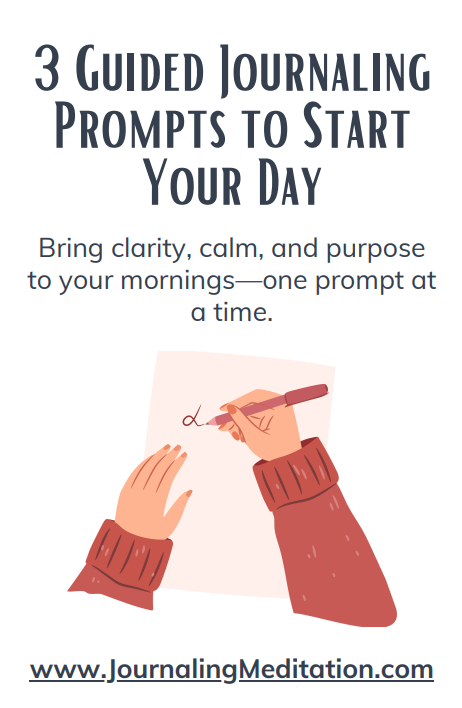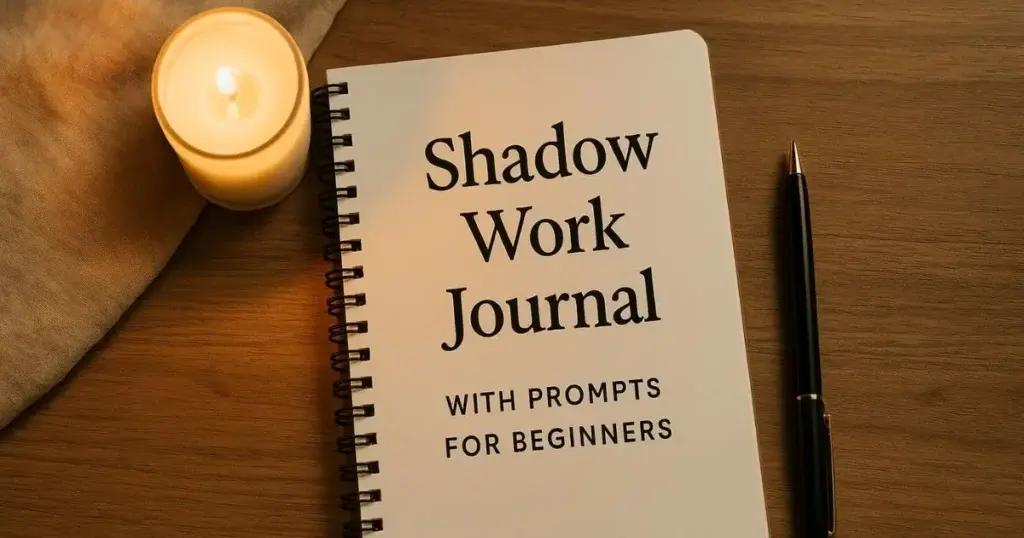
Updated 9/25/2025
Everyone has a “shadow”. That set of feelings, traits, or memories we tuck away where no one can see. How do you access such a sensitive part of one’s self? A shadow work journal with prompts for beginners is one of the gentlest, most effective ways to bring those hidden parts into light, allow for healing and support growth.
TL;DR / Key Takeaways
- Shadow work journaling helps uncover unconscious patterns, repressed emotions, and limiting beliefs so you understand yourself more authentically and clearly.
- Beginners benefit most from gentle prompts, regular but short journaling sessions, and safe, consistent environments that support all the above.
- There are different levels of prompts: self‑awareness, healing, relationships, identity, etc. You can progressively move deeper.
- Challenges are normal: discomfort, resistance, emotional overwhelm. Self‑compassion and sometimes guidance are key.
- This guide includes ready‑to‑use prompts, steps for doing shadow work well, troubleshooting, and FAQ aimed at beginners and those looking to deepen their practice.
What Is Shadow Work Journaling, & Why It Matters
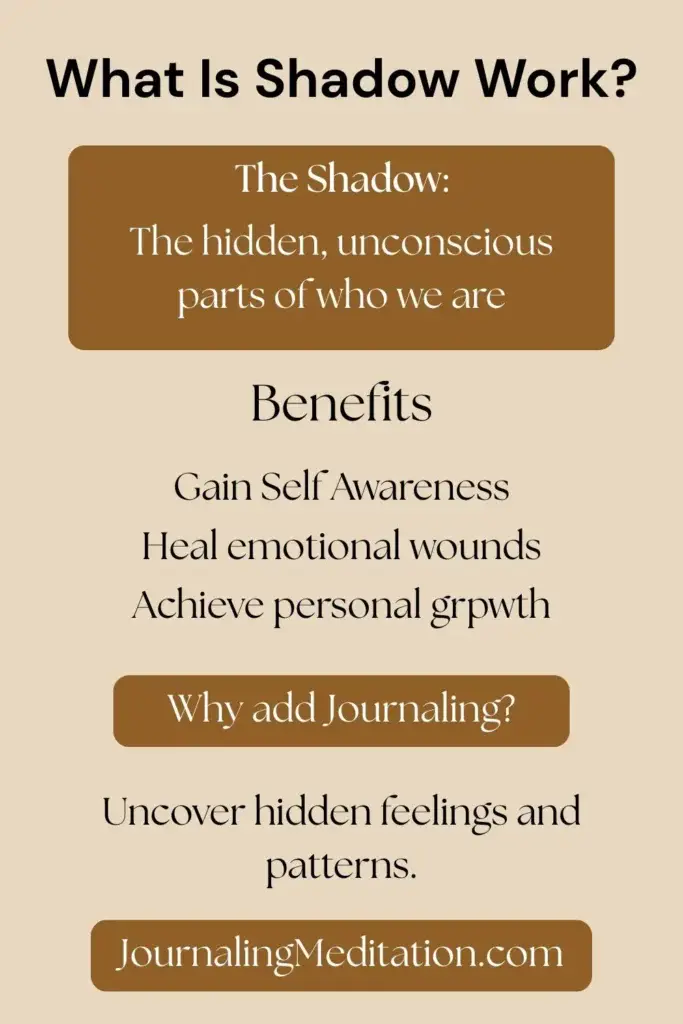
Shadow work is a psychological and spiritual practice, originating from the work of Carl Jung. It involves exploring the parts of ourselves we usually hide, deny, or suppress. These “shadow selves” influence how we feel, relate, and make choices, often without us knowing or realizing.
Journaling is a powerful tool for this exploration because writing can help clarify thoughts and feelings, track progress, and safely explore deep issues. When you combine journaling with prompts for beginners, you get structure + guidance, which makes starting less intimidating and progress more fruitful.
Foundational Concepts
What Is the “Shadow”?
When people hear “shadow,” they often picture something dark or ominous. But in shadow work, the shadow isn’t evil. It’s simply the unconscious parts of ourselves that we haven’t fully accepted. These could be traits we’ve been told or think are “too much,” emotions we learned to suppress, or memories we’ve quietly stuffed away.
As Carl Jung explained, the shadow holds all the aspects of ourselves that don’t fit into our “public” self-image. But that doesn’t make it bad. In fact, your shadow can also contain:
- Suppressed creativity
- Unexplored talents or desires
- Emotions that were never fully expressed, therefore truly felt
- Unacknowledged pain or unmet needs
In reality, the shadow is just the part of you waiting to be seen and reintegrated; with care, not judgment.
What Shadow Work Is. And What It Isn’t
Shadow work is the process of looking inward, gently shining light on what you usually avoid. It’s a practice of being honest with yourself, curiosity, and sometimes brave reflection. When done with compassion and given time for acceptance, it can lead to transformative shifts in how you relate to yourself and others.
Here’s what it is:
- A practice of self-inquiry: “Why did I react that way?”
- A chance to understand emotional patterns or triggers (This is where journaling can help)
- An opportunity to accept the parts of yourself you’ve labeled as “wrong” or “unlovable”
And what it’s not:
- A punishment session for having flaws
- A quick-fix for deep pain
- A one-time activity you do and then check off your healing to-do list
This isn’t about perfecting yourself. It’s about accepting all of you, even the messy parts.
Potential Benefits & Risks
Like most deep practices, shadow work brings both light and challenge. Let’s start with the good news: many people experience deep emotional clarity and transformation through consistent journaling.
Common benefits of shadow work journaling include:
- Increased self-awareness and emotional intelligence
- Stronger, more authentic relationships
- Healing past wounds and recognizing inner strengths
- Feeling more whole and aligned with your values
But it’s important to acknowledge that shadow work can also stir things up.
Potential challenges might look like:
- Emotional discomfort (grief, shame, anger surfacing or even resurfacing)
- Resistance or avoidance (“I don’t want to go there…”)
- Temporary confusion as old identities or beliefs dissolve or prove to be untrue
If this happens, take a breath. No, really. Slow down. Switch to gentler prompts or just free write. Reach out for support if needed (a therapist, mentor, or good friend).
Shadow work isn’t about digging until you feel like shit. It’s about meeting yourself with unconditional honesty and true compassion.
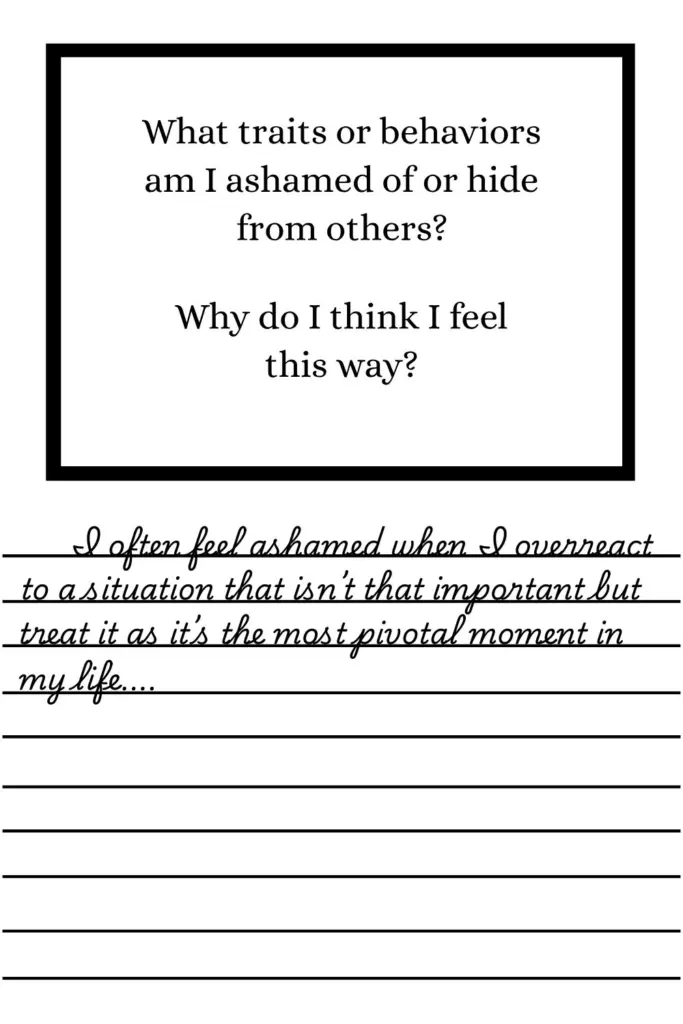
Getting Started — Practical Setup
Before just jumping into your shadow, it’s worth taking a few moments to prepare your space, your mindset, and your materials. You don’t need a perfect setup. Just one that makes you comfortable and feel safe enough to “go there.”
Let’s take a look at how to create a journaling practice that actually works for you, whether this is your first try with shadow work or coming back after a break.
Choosing a Journal That Fits You
You don’t need a fancy leather-bound tome (though hey, if that inspires you, go for it). What matters is that your journal feels like a safe space where you can be completely honest without judgment.
Here are a few things to consider:
- Paper or digital? Choose the format that feels most natural and private. Some people like handwriting for its grounding effect, while others prefer the convenience of apps.
- Blank, lined, or prompted? A blank page gives you full freedom, while a guided journal (like this one) can help when you don’t know where to start.
- Size and vibe: You might want something small and portable or something that lives on your nightstand with space for really getting into the substance.
Whatever you choose, the most important part is that it invites honesty, not perfection.
Want a Done-for-You Shadow Work Template?
If you’d rather not start from scratch, I’ve created The Daily Shadow Work Journal PDF Download – a printable PDF with 90 guided prompts. It’s beginner-friendly, cleanly designed, and totally printable or tablet-friendly.
👉 Click here to check it out for just $4.97
Creating the Right Environment
Let’s be honest: shadow work can stir up some pretty painful stuff. Having a space that feels intentionally yours can make a big difference. You don’t need a designated meditation room. Just a corner for calm is enough.
Try this:
- Pick a quiet spot where you won’t be interrupted, even if it’s just your parked car or a blanket fort made of grown-up blankets.
- Create a routine: Light a candle, take a few breaths, sip tea, stretch. These tiny cues help your body shift into “inner work mode.”
- Set a time frame: Knowing you have 15–20 minutes set aside gives you structure without pressure.
You’re letting yourself know, “This is a safe space to feel things.”
Establishing a Sustainable Routine
Shadow work journaling doesn’t need to be daily to be effective. In fact, giving yourself time to reflect between sessions can be more productive than trying to force daily introspections.
Instead of aiming for intensity, aim for consistency + kindness.
Consider:
- Start with 1–3 sessions per week. This is just enough to build momentum, but still not overwhelm.
- Use a simple tracker (pen and paper, calendar app, mood journal) to reflect on how you’re feeling before and after sessions.
- Adjust as you go. Some weeks may feel heavy. Some prompts may hit harder. Take your time and be understanding. That’s part of the process.
It’s okay if your journaling practice comes and goes. What matters is that you come back, no matter what, again and again.
Using Prompts Effectively
Shadow work journaling can feel a little… intimidating at first. That’s where prompts come in. Now they’re not to box you in, but to give you an opening. The right prompt can help you go deeper than surface-level thoughts and open up parts of yourself you’ve quietly avoided for years.
But here’s the thing: a good prompt is only as powerful as the way you work with it. So let’s talk about how to get the most out of them.
What Makes a Good Prompt?
Not all journaling prompts are created equal, especially when it comes to shadow work. You’re not here to list what you ate for lunch. You’re here to explore your unconscious, so your prompts need to meet you at that level.
A truly effective prompt will usually:
- Be open-ended, giving you space to explore your thoughts and feelings without trying to guide you one way or the other.
- Invite emotional honesty, even if it’s uncomfortable. Not so much “What made me happy today?”, but more “What am I afraid others might see in me?”
- Bring attention to your past patterns or present triggers, helping you notice where the shadow might be trying to speak up.
If a prompt makes you pause, resist, or feel something stir, you’re probably onto something worth exploring.
How to Engage Deeply with Prompts
Now that you’ve got a prompt that opens the door, how do you actually walk through it? The goal here is depth, not perfection. You don’t need pretty sentences, polished grammar or pretty penmanship (though being legible is extremely helpful for reflections!). You just need honesty.
Here’s how to make your journaling more than just a routine:
- Free-write whatever comes to mind. Don’t censor yourself. Let the “messy” stuff just flow. That’s often where the gold is. No one will see.
- Pay attention to actual sensations in your body as you write. Tightness in the chest? A lump in the throat? The body can remember what the mind forgets.
- After writing, take a moment to reflect on what surprised you, what patterns you noticed, or maybe where your emotions elevated.
This journaling can be thought of as a mirror. Not just for what you think, but for what’s been hiding behind your thoughts.
When to Move Beyond Beginner Prompts
Eventually, you may find that the gentler prompts aren’t stretching you the way they used to. That’s a good sign. It doesn’t mean you’ve “completed” shadow work (spoiler: there’s no finish line), but it does mean you’re building emotional strength and readiness. Level up!
You might be ready for deeper work if:
- You notice repeating themes or answers showing up in different prompts
- You feel less reactive and more curious toward uncomfortable emotions
- You find yourself asking harder questions… even without a prompt
At this point, maybe it’s time to start working with prompts that explore things like:
- Shadow projections: What traits in others really get under your skin.
- Family and identity wounds: The beliefs you took on before you knew you had a choice
- Archetypes and inner parts: Getting to know the voices inside you (inner critic, wounded child, protector, etc.)
When you’re ready, the prompts can grow with you. There’s no rush, just reflection.
The magic of shadow journaling isn’t in finding perfect answers. It’s in asking the kinds of questions you used to run from and realizing you’re strong enough to think about them now.
Sample Prompts You Can Use Today
Here are a few prompts organized by level. When ready, try a few and pace yourself.
For Self‑Awareness / Understanding Your Shadow (Beginner)
- What values was I taught growing up and do I live by them now?
- When do I feel most “less than” others, and what beliefs underlie that feeling?
- What traits in others irritate me, and what might they reflect in myself?
For Dialogue / Integration
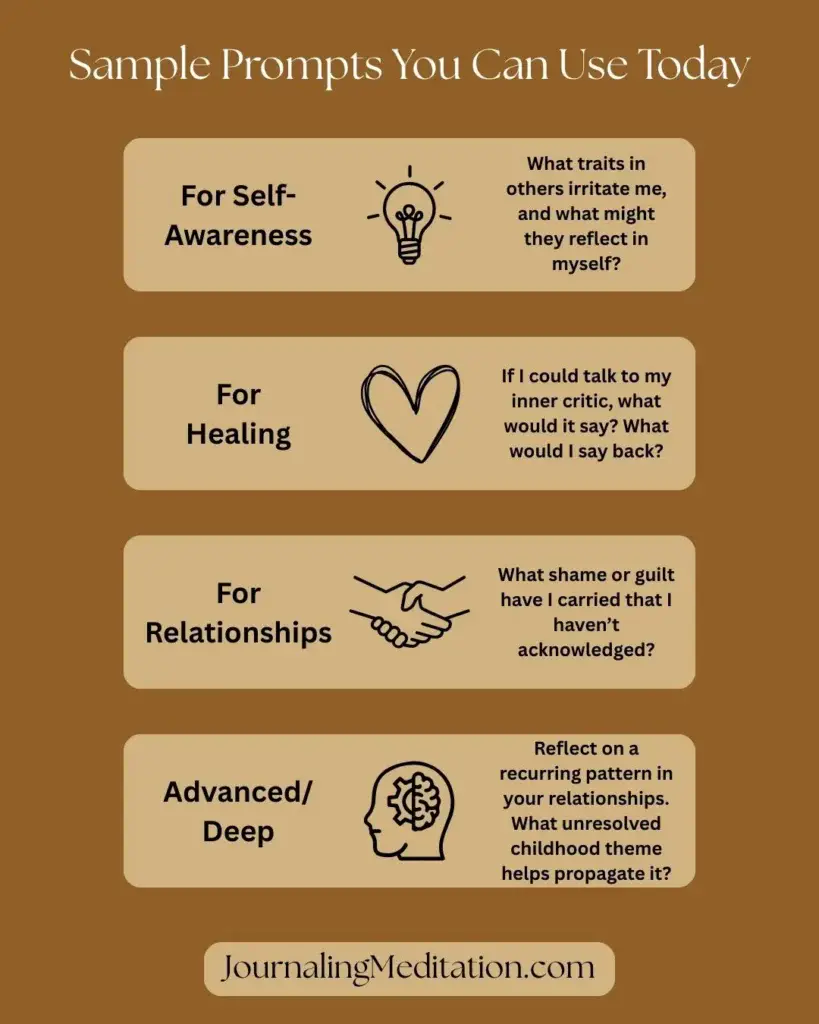
- If I could talk to my inner critic, what would it say? What would I say back?
- What part of me have I hidden from others because I fear rejection? What would it take to share just a sliver of that safely?
For Healing & Growth
- What shame or guilt have I carried that I haven’t acknowledged?
- What childhood memory still shapes how I respond to feedback or criticism?
Advanced / Deep Prompts (for returning readers)
- Reflect on a recurring pattern in your relationships. What unresolved childhood theme helps propagate it?
- What beliefs about identity (race, gender, success, spirituality) do I accept without question? Which ones would I challenge, and why?
Troubleshooting & Challenges
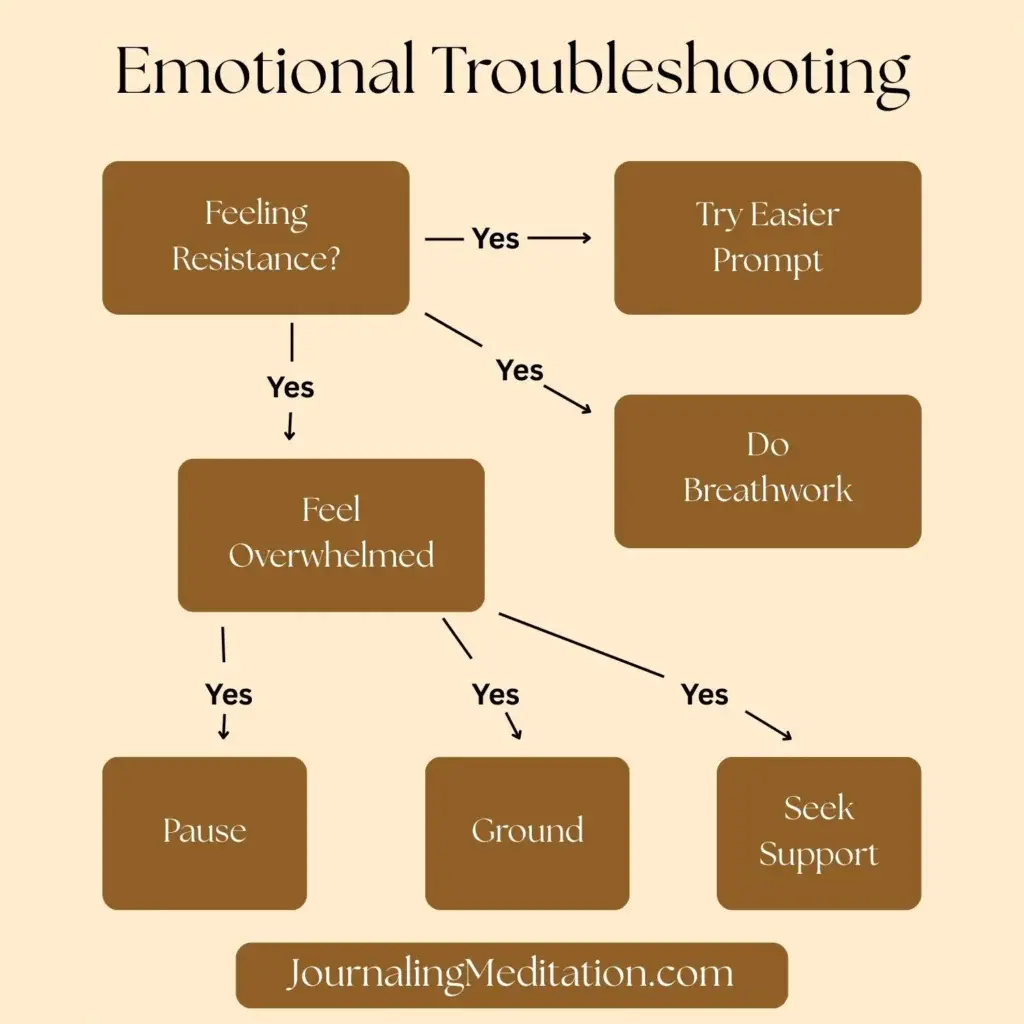
- Resistance/Avoidance: You might skip prompts, feel numb, or deflect. That’s natural and 100% ok. Acknowledge the issues. Sometimes slowing down or choosing gentler prompts helps.
- Emotional Overwhelm: If tears, anxiety, despair come up, pause, do some grounding work (breathing, walk outside) or reach out to someone supportive.
- Self‑Criticism/Shame Loops: When writing leads to harsh self‑judgment, counterbalance with self‑compassion. Remind yourself that exploration does not equal perfection.
Improving Your Practice
- Use tools that will help you: Guided meditation, breathwork, art, movement (dance, yoga) to help express what words may not be able to.
- Visual & structured support: Use printable templates, mood trackers, a list of prompts. Seeing growth in physical form really reinforces progress.
- Integration rituals: After intense journaling, do something soothing. Take a walk, have tea, or even journal about what you want to do differently.
FAQ — People Also Ask
If you’re wondering how to begin with a shadow work journal with prompts for beginners, these FAQs address some of the most searched and helpful queries. Whether you’re looking for safety tips, frequency advice, or how to tell when you’re making progress, you’ll find it here.
What is the best way to start shadow work journaling?
- Begin with gentle, beginner‑friendly prompts that feel somewhat familiar and comfortable.
- Set aside a regular, uninterrupted time and place so your mind knows this is dedicated reflection time.
- Start with short sessions (10‑20 minutes) initially; it’s more sustainable and less overwhelming.
How often should I use prompts in a shadow work journal?
- There’s no “one‑size‑fits‑all” schedule so try to listen to your energy.
- Many beginners benefit from 2‑3 sessions per week. As you become more comfortable, maybe daily or every other day.
- Allow rest/rejuvenation days. Shadow work isn’t about burning out. It’s about staying curious with kindness.
Is shadow work journaling safe for trauma survivors?
- It can be, but safety is paramount. Make sure you have support (therapist, trusted friend) if you are exploring significant trauma.
- Use gentle prompts first. Don’t force full stories if you’re not ready. Grounding practices and self-compassion are key.
- Pause if emotions become too intense; self‑care and possibly professional support are reasonable steps.
How do I know if my shadow work journal is helping?
- You’ll likely begin noticing patterns: recurring thoughts, triggers, relational dynamics that you hadn’t paid attention to before.
- More awareness of emotions and less automatic reactivity. Moments of insight (“Oh, so that’s why I feel anger in those situations”).
- Over time, increased self‑compassion turns to shifts in behavior (such as setting boundaries, speaking up or choosing differently).
Do you have a question I didn’t cover? What’s the prompt that has surprised you the most or helped you see something new about yourself? Leave a comment! I’d love to hear your stories.





